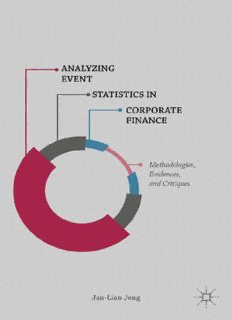
Analyzing Event Statistics in Corporate Finance: Methodologies, Evidences, and Critiques PDF
Preview Analyzing Event Statistics in Corporate Finance: Methodologies, Evidences, and Critiques
ANALYZINGEVENT STATISTICS IN CORPORATEFINANCE This page intentionally left blank Analyzing Event Statistics in Corporate Finance Methodologies, Evidences, and Critiques Jau-Lian Jeng ANALYZINGEVENTSTATISTICSINCORPORATEFINANCE Copyright©Jau-LianJeng,2015. Allrightsreserved. Firstpublishedin2015by PALGRAVEMACMILLAN® intheUnitedStates—adivisionofSt.Martin’sPressLLC, 175FifthAvenue,NewYork,NY10010. WherethisbookisdistributedintheUK,Europeandtherestoftheworld, thisisbyPalgraveMacmillan,adivisionofMacmillanPublishersLimited, registeredinEngland,companynumber785998,ofHoundmills, Basingstoke,HampshireRG216XS. PalgraveMacmillanistheglobalacademicimprintoftheabovecompanies andhascompaniesandrepresentativesthroughouttheworld. Palgrave®andMacmillan®areregisteredtrademarksintheUnitedStates, theUnitedKingdom,Europeandothercountries. ISBN:978–1–137–39717–1 LibraryofCongressCataloging-in-PublicationDataisavailablefromthe LibraryofCongress. AcataloguerecordofthebookisavailablefromtheBritishLibrary. DesignbyNewgenKnowledgeWorks(P)Ltd.,Chennai,India. Firstedition:February2015 10 9 8 7 6 5 4 3 2 1 Contents Preface vii Acknowledgments xi Part I Event Study Methodology I Chapter1 DataCollectioninLong-Run orShort-RunFormat? 3 Chapter2 ModelSpecificationsforNormal(orExpected)Returns 29 Chapter3 CumulativeAbnormalReturns orStructuralChangeTests? 83 Part II Event Study Methodology II Chapter4 RecursiveEstimationforNormal(orExpected)Returns 121 Chapter5 TimeWillTell!AMethodwithOccupationTimeStatistics 135 Epilogue 169 Notes 173 References 177 Index 185 This page intentionally left blank Preface T he literature on the corporate finance is so abundant that, ever since the pioneering work of Fama, Fisher, Jesen and Roll (1969), many research articles are published every year for event studies. Although many new methodologies are devised, empiricalcorporatefinanceisstillstrugglingfromcontroversies of many issues such as proper data collection, time-horizon decisions, event period determination, and robust statistical procedures. These issues certainly are not easy tasks for any researcheroranenthusiasticgraduatestudentineconomicsand financetoresolvethempromptly.Theaimofthisbookhenceis notsettoprovideanswerstoalltheseissues,either.Instead,the intent is to reiterate the necessary cautions in analyses on the event studies in corporate finance and to provide some alter- natives. Therefore, this book aims to become a reference for the researchers, graduate students, and professionals who are interestedinexploringthepossibleimpactsofcorporatefinance events rigorously. Starting from data collection, researchers should be careful in identifying the issues of interest and the representativeness of data set. Before anything starts, one can’t be more cautious than to investigate the intrinsic (time-series/cross-sectional) properties of the data introduced either from the sampling schemes or from the nature of the data themselves, particu- larly associated with financial times series. More importantly, althoughitistemptingtoexplorealldifferentmodelsorregula- rities that possibly can explain the financial data, all models or proposals for these data should provide sufficient verifications from the foundation of financial economics. Or, even more viii PREFACE pleasingly, these models should provide some better ones in theories or rigors if possible. The contents of the book starts from Chapter 1 that surveys (a) the issues of event-oriented constructed data and (b) the inclusion of firm-specific attributes as variables for empirical asset pricing models and leads to the importance of model search for the normal (or expected) returns. The task then is continuedinChapter2wherediagnostictestsforthenondiver- sifiability of factor-oriented variables in empirical asset pricing models (for normal returns) are covered. Although various specification tests or model selection criteria have been applied to the empirical asset pricing models, only a few of them emphasizethepre-requisitethattheseincludedvariablesshould be nondiversifiable so that separation between normal (or expected) returns versus abnormal returns can be well stated. In essence, many empirical research results on corporate event studies are questioned since the findings can either be the outcomes of events or model specification errors (in normal returns), or both. Criticism results since little justification in (model search for) empirical asset pricing models is done prior to applications of abnormal returns. Chapter 2 in this book attempts to provide somealternatives. Formanystudiesincorporatefinanceorfinancialeconomics, studies based on abnormal returns are applied in the verifi- cations of events. Conventional studies either apply the cumulative abnormal returns or perform the regressions of abnormal returns onfirm-specific attributes toobtain statistical tests. Either way, the hypothesis of interest is to verify that whether the mean of abnormal returns is nonzero within the eventwindowornot.Thisinturns,showsthatthehypothesisis equivalent to verification of structural changes of means parti- cularly, in abnormal returns. If empirical asset pricing models with regressions are applied to obtain both the normal and abnormal returns, the hypothesis of interest is equivalent to a structural change of parameter(s) in regressions over the event window. Given so, it is not difficult to see that the conven- tional tests such as cumulative abnormal returns (CARs) (with normalityornot)aresimilartotheCUSUM(cumulativesums) tests for parameter changes—at least, from the perspective of hypotheses. PREFACE ix Although the asymptotic arguments of CUSUM tests are mostly based on Brownian motion, the applications and hypotheses of CUSUM tests coincide with those of CARs tests in using the cumulative sums of abnormal returns or residuals from regressions of empirical asset pricing models. Chapter 3 argues that the deficiency of conventional CARs tests in event studies is bound to appear since financial time series almost always contain parameter changes even if there is no significant event at all. Hence, using CARs tests is not entirely robust to verify the impacts of events even though the empirical asset pricing models for normal returns are selected properly. The same critique applies to the CUSUM- based (monitoring) tests for parameter changes of empirical asset pricing models as well. It is hardly conclusive to consider that parameter changes are solely the results of firm-specific events. Many financial time series (and the proposed models in using them) are usually subject to time-varying parametri- zation.Thesearguments show thatthetests simplybaseonthe meanchanges ofabnormal returns arenotsufficient enoughto tell whether the impacts from the events are significant or not. Some alternatives must be provided to investigate the strength ofimpactsfromeventswithoutincurringthesimilaritybetween CARs tests and CUSUM tests for structural changes. Chapter 4 is prepared as a prerequisite for Chapter 5. Given the model identified in model search, the possible time- varying coefficients are taken into account. The intuition is, if the capital market adjustments are successfully efficient, the updating mechanism should possibly incorporate concurrent information into the normal (or expected) returns. Likewise, in forming the normal (or expected) returns, the recursive estimation should be introduced to accommodate the time- changing expectations of the market. Notice that these updating procedures apply only the systematic (nondiver- sifiable) information provided from the model(s) identified earlier. Therefore, the residuals resulted from the time-varying coefficientmodelsofnormal(orexpected)returnsapproximate closer to the abnormal returns as planned. Loosely speaking, this approach provides a better classification between normal and abnormal returns. In addition, the recursive algorithms applied do not assume some particular estimation periods or,
Description: